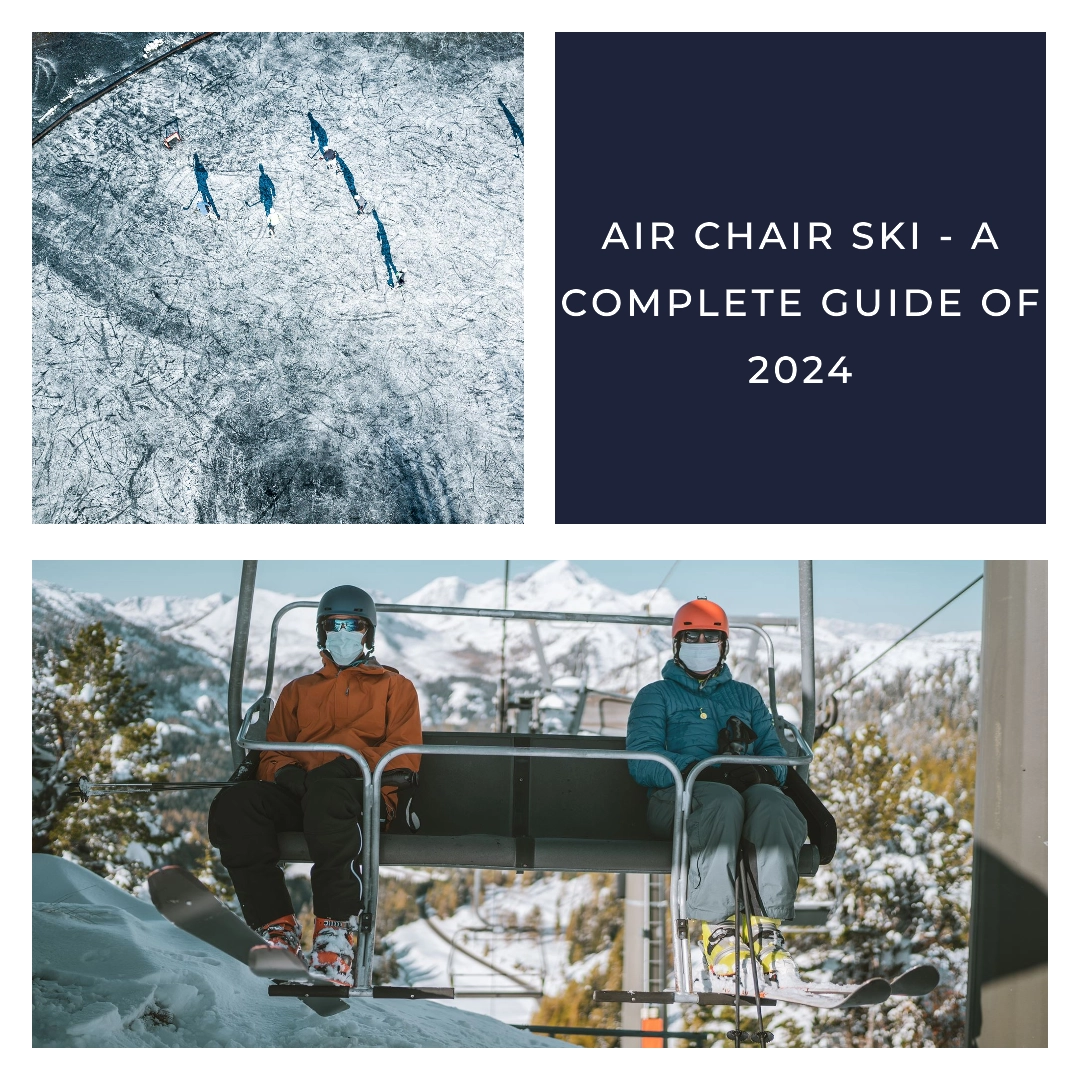Air chair ski marks a significant evolution in the world of water sports, introducing a novel way to glide above water. Unlike traditional skiing methods that maintain direct contact with the water surface, air chairs leverage hydrofoil technology. Attached to a 3-foot post, the hydrofoil beneath the chair creates lift, allowing the rider to float and maneuver above the water effortlessly. This innovative approach not only enhances the thrill of skiing but also opens up new possibilities for performing professional level tricks. Enthusiasts looking to dive into this sport can find a wealth of information through instructional videos and forums, where pro riders and community forums offer insights and tips for getting started and improving skills.

How to ride an airchair? Step-by-step guide
Step-01- Set up the airchair
Starting your journey with air chair skiing requires understanding the equipment. The first step is to familiarize yourself with the air chair through the instructional video provided, focusing on the assembly and adjustments necessary for optimal performance. This involves reading the manual in detail, identifying each part of the hydrofoil and the chair, and learning how they fit together. Proper setup is crucial, as it affects stability, control, and safety on the water. Beginners are encouraged to seek advice from forums and new threads on kayak accessories and hydrofoil boards to ensure they are setting up their equipment correctly. Engaging with the community can also provide practical tips and tricks not found in the manual, further enhancing the setup process.
Step-02- Set up the blades
The blades of the hydrofoil play a vital role in the dynamics of air chair skiing. There are two main blades – the front and the rear. The front blade, designed with a triangular shape and equipped with fins, is responsible for the majority of the lift. It is essential for beginners to understand how the shape and design of the front blade aid in stability and ease of learning. The rear blade, with its rounded shape, contributes to maneuverability, allowing riders to make precise movements on the water. Setting up the blades correctly is pivotal, as their alignment and tightness directly impact the air chair’s performance. Discussing blade setup in forums dedicated to waterski accessories and hydrofoil boards can provide additional insights and help troubleshoot common issues.
Step-03- Insert the wedge
The wedge is a critical component in tuning the performance of the air chair. It adjusts the angle of attack and the lift generated by the hydrofoil, significantly affecting how the air chair responds during skiing. Proper insertion and adjustment of the wedge allow riders to customize their ride according to their skill level and riding preferences. Medium-sized angles are generally recommended for a balance between lift and control, but experimenting with different sizes can fine-tune the experience. Engagement in community forums and discussion on waterski accessories can offer valuable advice from experienced riders on optimizing wedge placement for better handling and performance.
Step-04- Tightening all the bolts
Ensuring all bolts are securely tightened is a fundamental step in preparing the air chair for the water. This step is crucial for maintaining the structural integrity of the air chair and the safety of the rider. It involves checking each bolt on the base and the blades, as well as securing the post into the chair. The use of a safety pin through the shaft is an additional measure to prevent the post from detaching. Proper tightening techniques, avoiding over-tightening, and regular checks for any looseness are practices that should be adopted by every rider. For those new to the sport, seeking advice on forums about kayak accessories and hydrofoil board maintenance can help ensure that all components are correctly and safely assembled.
Step-05- It’s turn to get into the water
With the air chair fully assembled and checked, the next step is to prepare for entering the water. Wearing a life jacket is mandatory for safety, providing buoyancy and protection in case of falls. Choosing the right life jacket from popular brands can add an extra layer of confidence for beginners. As you approach the water, carrying the air chair might seem daunting due to its size and weight, but its design ensures it won’t sink once the hydrofoil and blades are properly attached. This moment marks the transition from preparation to action, as the anticipation of the ride builds.
Step-06- Place the air chair into the water
Introducing the air chair to the water is a thrilling moment for any rider. Despite its initial appearance, the chair is designed to float effortlessly thanks to the hydrofoil. Ensuring the blades are correctly attached is key, as this will keep the air chair stable and slightly above the surface, ready for the rider. The first contact with water is critical, setting the stage for the adventure ahead. Beginners might find this step intimidating, but with practice, it becomes a routine part of the exciting experience of air chair skiing.
Step-07- Slide your legs through the seat belt
Securing yourself to the air chair is a crucial safety measure. Begin by loosening the seat belt enough to comfortably slide your legs through. This step ensures that you are firmly attached to the chair, minimizing the risk of slipping off during maneuvers. The heel strap plays an essential role in this process, providing additional support and stability by securing your feet within the booties. Proper adjustment of the seat belt and heel strap not only enhances safety but also improves control over the air chair, allowing for more precise movements on the water. For those new to the sport, engaging with community forums and instructional videos on waterski accessories can offer practical advice on how to correctly use these safety features.
Step-08- Adjust Your Seating Position
Once secured in the air chair, finding the optimal seating position is key to maintaining balance and control. The ideal position involves sitting back in the seat, allowing your weight to be evenly distributed. This posture provides a stable base from which to steer and maneuver the air chair. Adjusting your seating position may require some trial and error, but finding the right balance between comfort and control is crucial for a successful ride. Tightening the seat belt after adjusting your position ensures that you remain secure, even during complex maneuvers or when adjusting your height above the water. Tips for finding the best seating position can often be found in instructional videos and forums, where experienced riders share their insights.
Step-09- Grab the Rope
With the air chair positioned in the water and your seating adjusted, the next step is to grab the tow rope. This is your lifeline to the boat and a critical tool for steering and balancing. The rope should be held with both hands, positioned in front of you, aligning with the direction of the boat. As the boat starts to move, allow yourself to be pulled gently at first, maintaining a straight line and keeping the air chair aligned with the boat’s path. This initial phase is crucial for gaining momentum while keeping control. Practicing this step can help build confidence and improve your ability to steer and balance as the speed increases.
Step-10- Steer with the Rope
Steering the air chair using the rope is a technique that requires patience and practice. As you gain speed and become more comfortable on the water, you will start to steer by slightly moving the rope to the left or right. This action shifts your weight and the direction of the air chair. Mastering this steering technique is essential for navigating turns and performing professional level tricks. It’s important to start with small adjustments to understand how the air chair responds. Over time, you will develop a feel for how much movement is needed to steer effectively. Engaging with pro riders through forums and instructional videos can provide additional tips and techniques for refining your steering skills.
Step-11- Maintain Straight Posture
Maintaining a straight posture while riding the air chair is crucial for stability and balance. Your spine should be aligned and perpendicular to the water, with your arms extended and slightly bent at the elbows. This posture helps distribute your weight evenly, making it easier to balance and steer the air chair. It’s similar to the balance required in other sports, like cycling, where maintaining a straight posture is key to controlling movement. Adjusting your posture in response to changes in speed and water conditions is part of the learning process, and with practice, maintaining a straight posture will become second nature.
Step-12- Balance Training
Balance is a fundamental skill in air chair skiing, requiring the rider to adjust their body’s position to maintain stability. This involves a delicate interplay between leaning forward to descend and leaning back to rise above the water. Initially, it’s common to oscillate between these two extremes as you find your equilibrium. Continuous practice on calm water can help develop a sense of how much to lean in either direction to achieve desired movements. Balancing not only involves body positioning but also the anticipation of the air chair’s response to your movements. Training sessions focused on balance are essential for advancing to more complex maneuvers and jumps.
Step-13- Height Control
Controlling your height above the water is an advanced skill that adds a dynamic aspect to air chair skiing. This involves using the rope and your body’s position to influence the hydrofoil’s lift. Lowering your arms decreases lift, bringing you closer to the water, while raising them increases lift, elevating you above the surface. Mastery of height control allows for smoother rides and the ability to perform jumps and other professional level tricks. It’s a skill that requires practice, as well as an understanding of the hydrofoil’s mechanics. Engaging with the air chair skiing community through forums and events can provide valuable insights and tips for mastering this aspect of the sport.
Step-14- Jumping and Landing
Jumping and landing are the pinnacle skills in air chair skiing, showcasing a rider’s control and mastery over the hydrofoil. Performing a jump involves timing, balance, and a precise sequence of movements. As you prepare for a jump, leaning back to increase lift, followed by a swift forward motion to initiate the jump, is key. Landing requires reversing these actions, ensuring a smooth re-entry into the water. These maneuvers demand a high level of skill and confidence, developed through consistent practice and guidance from experienced riders. Watching instructional videos and participating in wake 101 events can accelerate the learning process, providing a platform to share experiences and techniques for successful jumping and landing.
Conclusion
Mastering air chair skiing is a journey that combines the thrill of water sports with the challenge of balancing and maneuvering a hydrofoil. Each step, from setting up the air chair to executing jumps, builds upon the last, creating a comprehensive skill set that allows riders to explore the limits of this exciting sport. With patience, practice, and a willingness to learn from the community, enthusiasts can achieve proficiency in air chair skiing, enjoying the unique sensation of gliding and soaring above the water.

